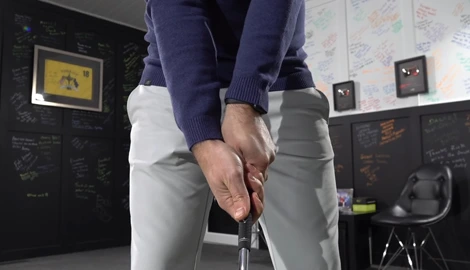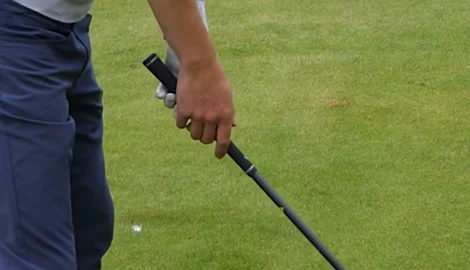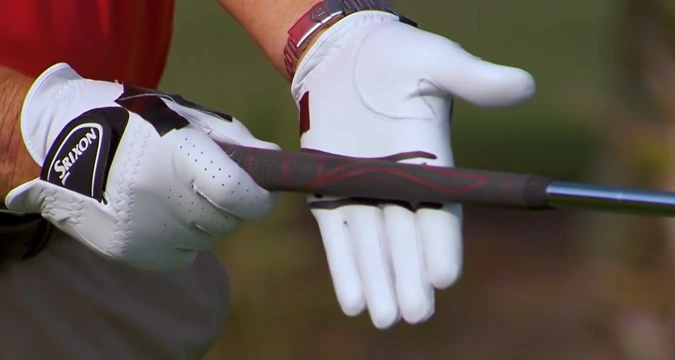Regardless of one’s level of interest or expertise, everyone who plays golf wants to have a good grip on their clubs. A good grip is essential for generating the power and accuracy needed to hit the ball properly. Unfortunately, many golfers find that their grip often feels uncomfortable.
A golf grip that is too small or too large can make it difficult to maintain control of the club and produce poor shots. On top of that, an uncomfortable grip can lead to blisters or hand cramps, which can be detrimental to your round.
So why does my golf grip feel uncomfortable, and how can I fix it? Thankfully, there are a few things that can be done to alleviate the problem. Let’s take a closer look.
Why Does My Golf Grip Feel Uncomfortable: Annoying Reasons

1. Your Grip is Too Tight:
Having a tight grip on your golf club is one of the most common reasons your grip feels uncomfortable when you grip the club too tightly, your muscles tense up, which can lead to fatigue and loss of power in your swing.
To fix this, try focusing on relaxing your hands and wrists as you hold the club. Practice making slow, smooth swings with a light grip to get used to the feeling. Once you’ve mastered it, you’ll be able to apply it to your full swing.
2. You’re Not Using The Proper Size Grips:
Using the wrong grip size can also cause your golf grip to feel uncomfortable. If the grips on your clubs are too large or too small, it will make the club twist in your hand, which results in discomfort and loss of control.
Make sure you’re using grips that are sized appropriately for your hands, if in doubt, ask a professional at your local golf shop for help. They’ll be able to recommend the right size grips for you based on the size of your hands.
3. You’re Not Using Leather Grips:
If you’re not equipped with leather grips, that could be another reason why your golf grip may feel uncomfortable. Leather grips provide a more comfortable and secure grip than other types of grips, like rubber or corded grips.
They also absorb sweat better, which can help keep your hands dry and prevent slippage during your swing. In case you do not currently use leather grips, consider switching to them; you may find they make a big difference in how comfortable your golf grip feels.
4. You Might Be Gripping The Club In The Wrong Place:
If you’re holding the club incorrectly, you might have a difficult time gripping the club comfortably. Most people tend to grip the club too far down on the handle, which makes it difficult to control the shot.
The best way to find the right place to grip the club is to put your left hand across the club between your thumb and forefinger. Then, put your right hand underneath the club so that it’s resting in between your pinkie finger and forefinger. This should give you a sturdy grip on the club and prevent making it too difficult to control.
5. The Grip Is Worn Out or Damaged:

If you have been using the same golf club for a while, it’s possible that the grip has become worn out or damaged. This can cause discomfort, besides making it difficult to maintain a firm grip on the club.
The solution is to simply replace the grip with a new one. This is a relatively easy and inexpensive fix that can make a world of difference in terms of comfort and performance.
6. You Have Sweaty Hands:
If you have sweaty hands, this will also make your grip uncomfortable. Sweaty hands can cause the club to slip out of your hands easily and can also lead to discomfort and chafing.
The solution is to pick a grip size that feels comfortable in your hand and to make sure you wipe down your clubs and grips often (especially if they become slippery). You may also want to consider using a golf glove if you have particularly sweaty hands.
7. The Weather is Hot and Humid:
Hot and humid weather can also lead to an uncomfortable golf grip. This is because hot weather can cause your hands to sweat more than usual, which, as we just discussed, can lead to discomfort and even slipping.
The solution is similar; use a grip size that is comfortable for your hands, use a golf glove if needed, and wipe down your clubs often (before and after each shot).
8. You Need to Replace Your Grips Regularly:
Even if you’re using the proper size and type of grips, you’ll still need to replace them regularly, typically once per season or every 40 rounds of golf, to ensure they remain effective. When grips get old, they can become hard and brittle, which can make them uncomfortable to use.
If it’s been a while since you’ve replaced your grips, that could be why they feel uncomfortable, give them a fresh start by replacing them with new ones at the beginning of each season (or sooner if they start to feel uncomfortable).
9. You Have an Underlying Medical Condition:
In some rare cases, an underlying medical condition may be giving you sore hands or wrists that make it difficult to use a golf grip comfortably. Conditions like arthritis, carpal tunnel syndrome, and nerve damage can all make it difficult or painful to hold a golf club properly.
If you think you might be suffering from a medical condition that’s causing discomfort in your hands or wrists, see a doctor for an evaluation, they’ll be able to diagnose the problem and recommend treatment options that can help relieve the pain and improve function so you can play golf comfortably again.
What Golfers Can Do to Achieve Comfortable Grip?

1. Choose the Right Equipment:
The first step in making sure my golf grip is comfortable is using the right equipment. If you’re using a grip that’s too small or too large, it’s going to be difficult to hold onto the club properly, and your hands will start to fatigue quickly. Make sure you try out different sizes and shapes until you get the right one for you.
2. Use the Right Tape:
If you’re still struggling with an uncomfortable golf grip, don’t be afraid to use tape. Tape can help fill in any gaps between your hand and the club, so you have a more secure grip.
Just make sure you use the right type of tape, if it’s too sticky, it will be difficult to remove, and if it’s not sticky enough, it won’t do a good job of keeping your grip in place.
3. Grip Lightly:
If you’re using a golf club with a steel shaft, you may be gripping the club too tightly. This can lead to tension in your wrists and arms, which can adversely affect your swing. Try using a lighter grip on the clubs with steel shafts and see if it makes a difference.
4. Use a Thicker Golf Grip:
Many golfers tend to use grips that are too thin. This may result in your hands slipping on the club during your swing and missing the ball entirely. Opt for a thicker grip instead so that you can maintain a secure hold on the club. This will help you make cleaner, more powerful swings and ultimately improve your game.
5. Invest in New Grips:
Worn-out grips can be one of the main causes of an uncomfortable golf grip. Once the material starts to wear down, it’s harder to keep a solid grip on the club. If you notice that your grips are starting to look worn, invest in new ones so you can keep playing your best game possible.
6. Change your Glove Size:
If you’re wearing gloves that are too small or too big, it can definitely affect your grip comfort levels. Make sure you’re wearing gloves that fit snugly but don’t feel constricting. This way, you’ll be able to get a good grip on the club without feeling like your hands are slipping all over the place.
7. Practice Good Hand Hygiene:
It’s important to practice good hand hygiene if you want to have a comfortable golf grip. Wash your hands before heading out to the course so they’re clean and free of sweat and contaminants.
Dry them off thoroughly so they don’t get slippery when you’re gripping the club. And if you start to feel any discomfort in your hands during or after your round, be sure to apply some hand lotion or cream to keep them healthy and hydrated.
8. Take a Break:
Sometimes, an uncomfortable golf grip is simply the result of overuse. If you’ve been playing a lot lately or practicing for long periods of time, your hands can start to tire, and the muscles can get cramped up.
The best way to combat this is by taking breaks throughout the day and stretching out your hands and wrists regularly.
Should Golf Grips be Tight or Loose?

There’s no definitive answer to the question of whether a golf grip should be tight or loose. There are several factors to consider, including the player’s strength, size, and preference.
A stronger player may prefer a tighter grip, while a weaker player may find it more comfortable to hold the club with a looser grip. Similarly, a taller player may need to adjust their grip to account for their long arms, while a shorter player may need to do the opposite.
Ultimately, it’s up to the individual golfer to determine which grip works best for him or her. So don’t be afraid to experiment until you find the right fit.
How Should a Golf Club Feel in Your Hands?
When you are choosing a golf club, it is important to find one that feels natural in your hands. The grip should be neither too thick nor too thin, and it should be made of a material that will not slip in your hand when you swing.
The weight of the club should be evenly distributed, and the clubhead should be the correct size for your height and the type of shot you are trying to make. If you are unsure about how a golf club should feel in your hands, it is best to consult with a professional before making a purchase.
Should Golf Grips be in Fingers or Palm?
The answer to this question depends on the individual golfer’s preferences and style. Some golfers prefer to grip the club between their fingers, as they feel it gives them more control over their shots.
Others like to grip the club in their palm, as they find it more comfortable and stable. Ultimately, there is no correct answer to this question; it is up to the individual to try a variety of grips and determine which one works best for them.
Does a Tight Grip Cause a Slice?
There is no definitive answer to this question, as there are many factors that can affect a golfer’s ability to hit the ball straight. But, some instructors argue that tight grips can cause a slice, as it can lead to the clubface being less open at impact.
Alternatively, others believe that a tight grip can help prevent a slice, as it gives the golfer more control over the club. Ultimately, it is up to each player to try out different grips and find what works best for them.
If you are struggling with a slice, it may be worth trying a tighter grip and seeing if it helps you hit the ball straighter.
How Tightly Do Pro Golfers Grip the Club?
It depends on a number of factors, including the type of club being used, the golfer’s swing speed, and the desired trajectory of the shot.
For example, a driver is typically gripped more tightly than iron, as the extra speed generated by the driver can lead to a loss of control if the grip is too loose. Likewise, a golfer with a slower swing speed may need to grip the club more tightly in order to generate enough power for the shot.
Ultimately, it’s up to each individual golfer to experiment with different grip strengths and decide which is most comfortable.
So, Let’s Get a Grip on the Uncomfortable Grip Situation!
Hopefully, by now, you’ve found a solution to your golf grip problems. After a long day on the golf course, it’s not unusual to find your hands feeling a little sore and stiff. Then again, if your grip feels uncomfortable every time you play, it could be a sign that something is off.
It would be best if you experiment with different grip sizes and positions until you find one that feels comfortable and gives you good control over the club. With a little trial and error, you should be able to find a grip that will help you enjoy your game even more. Thanks for reading.
Topics Worth Exploring:

